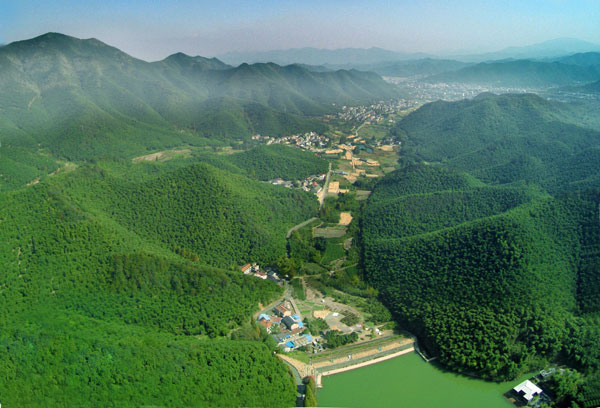Anji cleans up by cleaning up
By Yan Yiqi (China Daily) Updated: 2015-05-28 07:49Local authorities in Anji county, Zhejiang province, have proved that it's possible to stimulate and maintain economic growth without endangering the local environment. Yan Yiqi reports from Anji, Zhejiang province.
|
A bird's-eye view of Yucun village in Anji county, Zhejiang province. After the authorities closed down polluting factories, the village has been transformed into an ecological tourism hot spot after the local authorities closed down a number of polluting factories. Provided to China Daily |
In the past 100 years, Anji county has been a constant presence on the list of the poorest places in Zhejiang province. In fact, it has probably spent more time on the list than off it.
To improve the local economy, the authorities introduced a number of heavy industries in the 1990s, which rapidly helped the county to lose its "poverty-stricken" label.
However, success was a double-edged sword, and what the county gained in economic strength, it lost in environmental degradation as rivers and water sources became heavily polluted and the air quality plummetted.
By 2003, Anji was once again one of Zhejiang's poorest counties, but this time the economic downturn was cyclical and beyond the control of local decision-makers.
The decline led the county government to make the momentous decision to simultaneously develop the economy and safeguard the environment via a new model, which has resulted in Anji rising rapidly in the financial and "quality of life tables" during the last decade.
Now with bamboo, tea and tourism fast becoming the county's new pillar industries, Anji has successfully been transformed from an underdeveloped county to one of the richest in China's wealthiest province.
In 2014, local government revenue in Anji reached 5 billion yuan ($805 million), a year-on-year rise of more than 18 percent, with the city of Huzhou the best performer. That same year, the county was rated as one of the top five in the province.
As China's first "ecological county", Anji now has a forestry coverage rate of more than 80 percent - the largest in Zhejiang - and the water and air are among the cleanest in the province.
Environmental disaster
Looking at the green trees and clean rivers that abound today, it's hard to imagine that just 12 years ago Anji was a byword for industrial pollution as a result of the dye works, paper mills, cement factories, quarries and other high-polluting industries that had been introduced to boost the local economy.
Pan Wenge, director of the Yucun Village Administrative Committee, remembers how the environment was destroyed by pollution caused by the quarries that were first put into operation in the 1980s. At the peak, 65 trucks were in constant use, carrying tons of stone out of the village day and night.
"Quarrying used to be a pillar industry of the village. Smoke and dust filled the air, while the leaves of the trees were covered with thick layers of dust. Our furniture was always covered with dust, even though we never opened the windows" Pan said, adding that the dust also turned the hills from green to yellow as the local bamboo plants and a wide range of trees died.
"When I was a child, the village was surrounded by fruit trees, such as peach, pear and plum, but their fruit was no longer harvested in the 1990s," he said.
The dust was also dangerous to human health, and many villagers contracted pneumoconiosis.
Yucun resident Hu Jiaxing said he remembers that many of the villagers, some only in their 40s, were incapable of walking up a very slight incline.
"We were not aware of the disease back then," he said.
Pan said about 50 percent of Yucun's residents relied on quarrying, an industry that made many locals very wealthy. In 2003, annual per capita income in the village exceeded 7,000 yuan, making Yucun the richest in Anji, albeit against little competition.
However, the situation in the village was a microcosm of China - after two decades of developing high-polluting industries, it had become wealthy and powerful, but the environment had been destroyed.
- Govt encourages people to work 4.5 days a week
- Action to be taken as HIV cases among students rise
- Debate grows over reproductive rights
- Country's first bishop ordained in 3 years
- China builds Tibetan Buddhism academy in Chengdu
- Authorities require reporting of HIV infections at schools
- Typhoon Soudelor kills 14 in East China
- Police crack down on overseas gambling site
- Debate over death penalty for child traffickers goes on
- Beijing to tighten mail security for war anniversary








